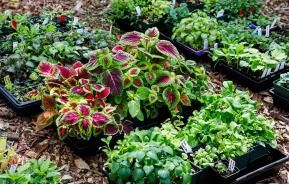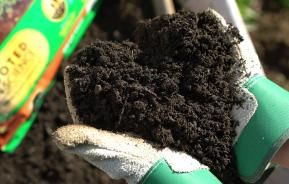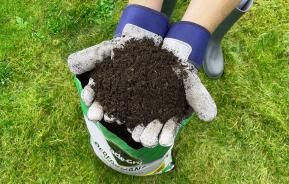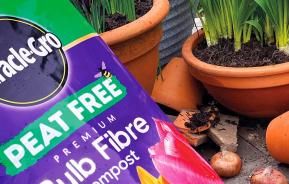Irises are a large group of fabulously colourful garden plants. Their brightly coloured flowers often have petals in different colours or with different coloured markings, producing exquisite colour effects.
The summer-flowering bearded irises or flag irises are probably the most popular and best known – with their large, bold flowers and evergreen, sword-like leaves – but there are also some fabulous bulb irises. Many of these flower in late winter and spring – making them essential garden plants. There are even irises for growing in ponds, around ponds and in bog gardens.
Among the bulb irises, the most popular is the ‘Reticulata’ group, short plants that flower from late winter. They are excellent rock garden plants and for growing at the front of borders and beds. They can also be grown as indoor pot plants – planting 6 bulbs in a 12.5-15cm (5-6in) pot – and will flower in mid to late winter.
The Dutch, Spanish and English bulb irises flower in summer, the Dutch irises being the first to do so.
How to grow irises
Iris growing conditions
All irises prefer a sunny position.
Flag and bearded irises
These irises prefer a fertile, well-drained neutral or slightly alkaline soil. They are also ideal for growing at the base of a sunny wall.
Bulb irises
These irises prefer a fertile, well-drained, slightly alkaline, light soil. Add lots of organic matter to the soil when planting and even add sharp sand or grit in heavy soils to improve drainage.
Aquatic and bog irises
These will tolerate lightly shaded positions and need permanently moist or even wet soils.
Iris varieties
Flag and bearded irises
There are literally hundreds of different varieties of bearded irises in a wide range of flower colours and heights. These range from Dwarf Bearded, growing 15-25cm (6-10in) high to Tall Bearded, growing up to 1.2m (4ft) high.
There are several specialist nurseries, which provide full descriptions and excellent images of the flowers, to help you decide which ones to grow. These include Claire Austin Hardy Plants and Cayeux.

Bulb irises
Reticulata Cantab (pale blue), Iris danfordiae (yellow), George (purple), Harmony (royal blue), Joyce (sky blue), Katharine Hodgkin (pale blue)
Dutch Discovery (violet blue), Purple Sensation (purple), Symphony (yellow), White Excelsior (white and yellow)
English King of the Blues (dark blue), Mont Blanc (white), Queen of the Blues (bright blue)
Aquatic and bog irises
These include Iris pseudacorus with yellow flowers in May and June, Iris sibirica with blue flowers in June and July, and Iris kaempferi with purple/blue flowers in June and July.

How to plant irises
Flag and bearded irises
These can be planted in spring or, better still, between July and mid-October.
If your soil is heavy clay, add coarse sand and bulky organic matter to improve drainage. The ideal pH is 7 (neutral), although not essential, so add garden lime to acidic soils, which is also good to improve clay soils.
Bearded irises are generally planted 30-40cm (12-16in) apart.
These irises must be planted so that the top of the rhizomes is slightly exposed above soil level and the roots are spread out facing downward. After planting, water in thoroughly to pack the soil around the roots.
Bulb irises
Dry Reticulata iris bulbs planted in autumn often fail to grow or don’t perform very well because they may have dried out too much. It is usually better to buy potted plants.
Always improve the soil with lots of added organic matter, such as compost, well-rotted manure, composted bark or planting compost.
Reticulata: plant 10cm (4in) deep, 10cm (4in) apart; Dutch and English: 5-7.5cm (2-3in) deep, 15-23cm (6-9in) apart.
Aquatic and bog irises
Plant in soil that remains permanently moist. Add lots of organic matter, such as compost, well-rotted manure, composted bark or planting compost, to help maintain soil moisture.
In ponds, it is easier to plant using pond plant baskets.
Suggested planting locations and garden types
Flower borders and beds, patios, containers, city and courtyard gardens, cottage and informal gardens, ponds, bog gardens.
Caring and feeding iris plants
Flag and bearded irises
Newly planted bearded irises need watering to help them establish. After that, they rarely need to be watered except in extremely hot, dry summers. It is always better to underwater than overwater, as too much water can induce rot.
Focus on feeding iris plants with a balanced or high potash general granular plant food in early spring and then again after flowering. Avoid using high nitrogen feeds as this can encourages rot problems.
Cut back the flower stems to their base after flowering.
Remove any diseased or brown leaves when you see them, and in autumn, cut off any old or dying leaves.
To continue caring for irises, old clumps should be divided every 3 to 5 years in July or after flowering before they become overcrowded and flowering is affected. Carefully lift the fleshy rhizomes with a garden fork. Select the largest fans of leaves with the healthiest rhizomes and cut these from the main plant with a sharp knife. Don’t bother with the smallest fans or very old or rotten rhizomes. Cut the leaves back horizontally about 15cm (6in) above the rhizome and trim back old and damaged roots.Dig a hole, large enough for the rhizome and roots – the rhizome should be placed at soil surface on heavy soils, a little below on light sandy soils – and firm the soil around them.
Bulb irises
The bulb irises are easy to look after and rarely need watering when growing in the ground, unless the soil dries out during prolonged dry periods.
Give them a light feed with a granular general plant food after flowering. Watering with a liquid plant food after flowering and until the foliage starts to die down will help build up their strength and size for the following year’s flowering.
Allow the foliage to die down naturally.
If the bulbs have been growing in the same soil for several years and no longer flower profusely, lift them after the foliage has died down, carefully split them into smaller clumps and replant at the same depth in soil that has had lots of bulky organic material and slow-release feed added. Only do this when absolutely necessary, as the plants dislike disturbance and should be left for 4 to 5 years at least.
Dutch irises may need winter protection with a cloche or similar covering during hard winters.
| Flowering season(s) | Spring, Summer, Winter |
|---|---|
| Foliage season(s) | Spring, Summer, Autumn, Winter |
| Sunlight | Full sun |
| Soil type | Chalky, Clay, Loamy, Sandy |
| Soil pH | Neutral |
| Soil moisture | Well-drained, Moist but well-drained, Poorly drained |
| Ultimate height | Up to 1.2m (4ft) depending on variety |
| Ultimate spread | Up to 60cm (2ft) depending on variety |
| Time to ultimate height | 3-4 years |








